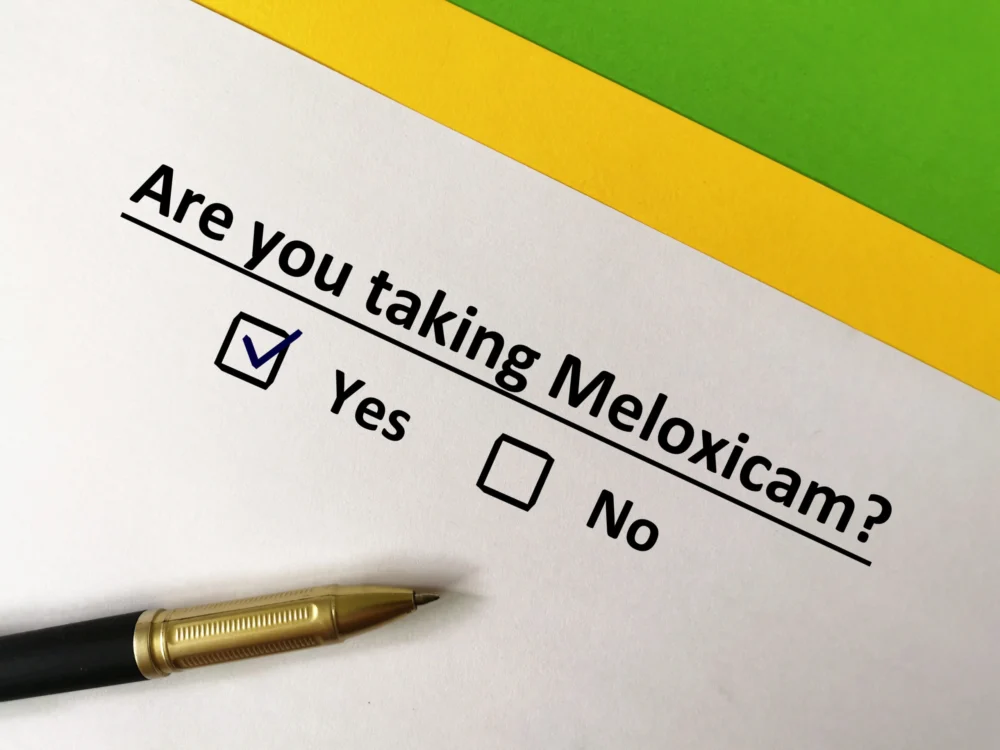People are always looking for an alternative to opioid painkillers, and some have found it in the form of therapy, yoga, acupuncture, or even meditation. As for medications, however, there may be an option for pain treatment in the form of a prescription NSAID (non-steroidal anti-inflammatory) drug called meloxicam. However, it is still important to know the facts about this drug before you begin taking it.
What Is Meloxicam?
Meloxicam is a pain-relieving drug. It is often used to treat forms of arthritis, including osteoarthritis and rheumatoid arthritis. This medication is part of the NSAID drug family. Though many other NSAIDs, like aspirin and ibuprofen, are over-the-counter medications you can buy at any drug store, meloxicam is stronger than these drugs and, as such, is only available by prescription.
In some circles, people are finding out that meloxicam could be a safer alternative to opioid painkillers, specifically because the former medication is not addictive. If you have a chronic pain issue, have had surgery, or have another problem for which you require painkillers, you might want to ask your doctor about meloxicam as an alternative to opioids.
Side Effects of Meloxicam

Like every drug on the market, meloxicam can cause certain side effects. It is important to be aware of these before you start taking meloxicam for any length of time. The most common side effects associated with meloxicam include:
- Diarrhea
- Gas
- Constipation
- Sore throat
All of these side effects are common and usually mild. In most cases, they will disappear in a few days or, at the very least, in a week or so. If you notice that they do not disappear, it is important to discuss the issue with your doctor.
Meloxicam can cause problems for the kidneys and stomach as well as ulcers, bleeding, and holes in the intestines. Those who already have kidney problems should probably refrain from taking meloxicam. It can also cause a higher risk of heart attack and increase blood pressure to the point of hypertension. Meloxicam can also cause an overdose if taken in higher amounts than prescribed. Whatever you do, make sure you understand the risks inherent with meloxicam before you begin taking it.
What Are Serious Side Effects of Meloxicam?
If you experience any of the following side effects, call your doctor immediately or get emergency medical treatment:
- Black, tarry stools
- Blood in vomit or stool
- Coughing up or vomiting blood or material that looks like coffee grounds
- Decreased urination or pain when urinating
- Numbness or tingling in your hands or feet
- Pale skin
- Shortness of breath
- Swelling of your face, lips, tongue, or throat
What Is Meloxicam Prescribed For?
Meloxicam is most commonly prescribed to treat pain and inflammation from conditions such as arthritis, gout, menstrual cramps, and other types of short-term pain. It can also be used for longer-term pain management if necessary but should only be done so under the supervision of a doctor. Meloxicam is not intended for use on an as-needed basis like other painkillers.
How Long Does Meloxicam Stay In Your System?
The half-life of meloxicam is between four and six hours, which means it will take approximately that long for the drug to be reduced by half in your system. The effects of meloxicam can last up to 12 hours. Meloxicam is not an addictive drug, however, it is possible to develop a tolerance to the medication over time. If you find that you need to take meloxicam more frequently or in higher doses to achieve the same level of pain relief, you should speak to your doctor.
How Should Meloxicam Be Used?
 Meloxicam should be taken orally with or without food. The recommended starting dose for most adults is 7.5 mg once daily. Your doctor may increase your dose to 15 mg once daily if necessary. The maximum recommended dose is 15 mg per day. If you have kidney disease, your doctor may start you on a lower dose of meloxicam and increase your dose more slowly.
Meloxicam should be taken orally with or without food. The recommended starting dose for most adults is 7.5 mg once daily. Your doctor may increase your dose to 15 mg once daily if necessary. The maximum recommended dose is 15 mg per day. If you have kidney disease, your doctor may start you on a lower dose of meloxicam and increase your dose more slowly.
What Special Precautions Should Be Taken Before Taking Meloxicam?
You should not take meloxicam if you are allergic to it or any other NSAIDs. You also should not take meloxicam if you have ever had an asthma attack or other allergic reaction caused by taking aspirin or another NSAID.
Before taking meloxicam, tell your doctor if you have ever had:
- Kidney disease
- Liver disease
- Ulcers or bleeding in your stomach or intestines
- Anemia (low red blood cells)
- Fluid retention or edema
- Heart disease or congestive heart failure
You may be more likely to have a heart attack or stroke while taking meloxicam, especially if you take it for a long time. Do not take meloxicam if you are pregnant or plan to become pregnant. Meloxicam can cause harm to the fetus.
Tell your doctor if you are breastfeeding. You should not take meloxicam if you are breastfeeding a baby.
Do not give meloxicam to a child without medical advice. Children are more sensitive to the effects of meloxicam.
What Should I Do if I Miss a Dose of Meloxicam?
If you miss a dose of meloxicam, take it as soon as possible. If it is almost time for your next dose, skip the missed dose and go back to your regular dosing schedule. Do not take 2 doses at once.
Store meloxicam at room temperature away from moisture and heat. Keep the bottle tightly closed when not in use.
Throw away any unused meloxicam that is older than 4 months old. Do not take this medicine if the expiration date on the label has passed.
Meloxicam can interact with other medications. Tell your doctor all prescription and over-the-counter medications and supplements you take. Meloxicam should not be taken with aspirin or other NSAIDs. Avoid drinking alcohol while taking meloxicam.
Is Meloxicam Addictive?
Meloxicam and its common brand names Mobic and Vivoldex are most often used to treat forms of arthritis. However, many patients and doctors are looking toward it as a nonaddictive alternative to opioids. Fortunately, meloxicam is not habit-forming like opioid painkillers are.
It does not change the way the brain chemistry works to create compulsive abuse.
However, meloxicam still has the potential for abuse. Some people take too much of the drug precisely because they think it is not addictive, leading to other problems. People misuse the drug for many reasons, and, in this regard, taking meloxicam does not completely rule out the issue of abuse.
Is Meloxicam Safer Than Opioids?
Many people are trying to find an alternative to opioids. These drugs have caused much of the US’s addiction, death, and ancillary health problems today. Meloxicam might be a helpful alternative, but it is still important to remember the truth about both drugs by comparing meloxicam to opioids.
Opioids and meloxicam both have their fair share of physical risks. Both can affect different bodily functions and organs dangerously. Even when taken as prescribed, certain side effects, like constipation, can create discomfort.
Meloxicam is not addictive in the way opioids are, yet it can still be abused. Sometimes people abuse meloxicam thinking it has opioids in it or simply because they want less inflammation and pain. This does not take away from the fact that opioids are far more addictive.
The answer to this question, depending on your situation, is that meloxicam might be a safer alternative for you than opioids. If you want to avoid opioid use because of the addictive nature of the drug and are otherwise healthy, meloxicam might be a beneficial option. But if you are not in good health, have kidney, stomach, or heart problems, or will be taking meloxicam for a prolonged period of time, it might not be the safest option for your pain treatment.
Treatment Options for Meloxicam Abuse
If meloxicam abuse is a problem, there are several options for treatment.
Detoxification is the first step in overcoming meloxicam addiction. This can be done on an inpatient or outpatient basis, depending on the severity of the addiction and possible withdrawal symptoms.
Once detox is complete, patients can enter a meloxicam rehab program. These programs can last anywhere from 30 days to 90 days, and sometimes longer, depending on the needs of the patient.
Inpatient meloxicam rehab programs offer around-the-clock care in a safe and structured environment. This allows patients to focus on their recovery without having to worry about everyday stressors.
Outpatient meloxicam rehab programs allow patients to live at home while attending treatment during the day. This can be a good option for those with milder addiction or who have responsibilities that can’t be put on hold, such as work or childcare.
Both inpatient and outpatient meloxicam rehab programs offer counseling and therapy to help patients overcome their addictions. Treatment typically includes:
- Individual counseling
- Group therapy
- Cognitive behavioral therapy
- 12-step or other support groups
- Medications to manage withdrawal symptoms and cravings (such as meloxicam)
After completing a meloxicam rehab program, patients may need to participate in ongoing recovery programs, such as 12-step groups or sober living homes, to maintain their sobriety.
Treating Meloxicam Abuse at Westwind Recovery®®®

Though meloxicam is not considered an addictive drug, some may still require addiction treatment after abusing it. This is often heavily associated with the treatment of health conditions caused by the drug’s misuse. However, some individuals require treatment for multiple substance use disorders. In many cases, those who abuse meloxicam are often struggling with other drug abuse problems as well.
If you believe your meloxicam abuse has gotten out of control, call Westwind Recovery®® to speak with a treatment advisor now. We are available 24/7 to take your call. We’ll help you reshape your life and make your future your own.

Dr. Deena is the Chief Clinical Officer of Westwind Recovery®, an award-winning outpatient treatment center in Los Angeles where she oversees the clinical and administrative program and treatment methods. Dr. Deena is a doctor of psychology and licensed clinical social worker since 1993. LCSW #20628. Originally from the East Coast, Dr. Deena has worked running treatment centers, worked as a therapist in psychiatric hospitals as well as school settings and currently has a thriving private practice in the LA area. Dr. Deena has appeared regularly on the Dr. Phil Show as an expert since 2003. She has also been featured on many other TV shows, podcasts and has contributed to written publications as well as podcasts.




